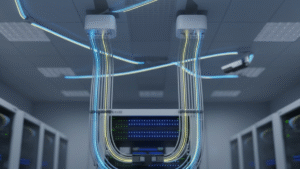In electronic devices and power systems, the choice of power supply is crucial. Depending on the application and requirements, switching power supplies and regular power supplies (also known as linear power supplies) are the two most commonly used types.
1. Comparison of Working Principles
Switching Power Supply A switching power supply utilizes high-frequency switching technology, where switching transistors rapidly turn on and off to convert input AC or DC voltage into the desired voltage and current. It employs pulse-width modulation (PWM) or other modulation techniques, along with inductors, capacitors, and transformers, to regulate and rectify the voltage, ultimately providing a stable output voltage.
Regular Power Supply (Linear Power Supply) A linear power supply typically involves a step-down transformer to reduce AC voltage, followed by a rectifier that converts AC to DC. A linear regulator then adjusts the voltage to the desired level. Due to the way linear regulators work, they dissipate excess energy as heat, leading to lower efficiency.
2. Key Feature Comparison
| Feature | Switching Power Supply | Regular Power Supply |
|---|---|---|
| Efficiency | High (up to 80% or more) | Low (typically 40%-60%) |
| Size & Weight | Compact and lightweight | Large and heavy |
| Heat Generation | Low (due to efficient conversion) | High (significant energy loss as heat) |
| Stability | Affected by electromagnetic interference | Low ripple, high stability |
| Complexity | Complex design, requires high-frequency components | Simple structure, easy to repair |
| Cost | Lower manufacturing cost | Higher cost due to bulky transformer |
Export to Sheets
3. Application Comparison
Applications of Switching Power Supply:
- Computer power supplies (PC and server power supplies)
- Communication equipment (routers, base station power supplies)
- Consumer electronics (mobile phone chargers, electric vehicle chargers)
- Industrial equipment (automation devices, LED driver power supplies)
- Medical devices (high-efficiency medical instrument power supplies)
Applications of Regular Power Supply:
- High-precision laboratory equipment (oscilloscopes, power analyzers)
- Audio equipment (high-fidelity amplifiers)
- Low-noise applications (laboratory instruments, measuring equipment)
- Electromagnetically sensitive environments (medical diagnostic equipment)
4. Advantages and Disadvantages Comparison
Advantages of Switching Power Supply:
- High efficiency, reducing energy waste
- Small size and lightweight, making integration easier
- Wide input voltage adaptability
- Lower production cost
Disadvantages of Switching Power Supply:
- Higher electromagnetic interference, which may affect nearby devices
- Complex design and repair requirements
- Higher output ripple and noise levels
Advantages of Regular Power Supply:
- Stable output voltage with low ripple and noise
- Simple structure with high reliability
- Minimal electromagnetic interference, ideal for precision applications
Disadvantages of Regular Power Supply:
- Low efficiency with significant energy loss
- Large size and heavy weight
- Higher manufacturing cost
5. Future Trends
With technological advancements, switching power supplies are becoming more dominant due to their efficiency, compactness, and high power density, replacing traditional linear power supplies in high-power applications such as data centers, electric vehicles, and renewable energy systems. Additionally, progress in EMI (Electromagnetic Interference) suppression technology is helping to mitigate the drawbacks of switching power supplies.
However, in applications requiring ultra-low noise and high precision, such as laboratory equipment and medical instruments, linear power supplies still hold an irreplaceable position. In the future, hybrid power supply designs that combine the advantages of both types—such as integrating high-efficiency switching power supplies with linear regulators—may become more prevalent to meet diverse industry needs.
Both switching power supplies and regular power supplies have their own strengths. The choice between them depends on the specific application requirements. If high efficiency, small size, and low cost are priorities, a switching power supply is the best choice. On the other hand, if stability, low noise, and high precision are crucial, a linear power supply remains the preferred option. As electronic technology evolves, future power supply designs will continue to improve in intelligence and efficiency to meet the demands of various industries.




